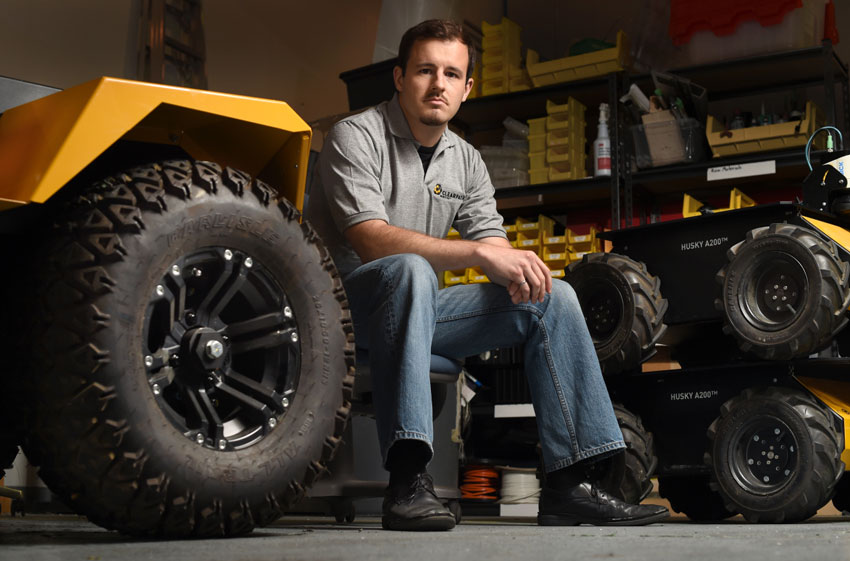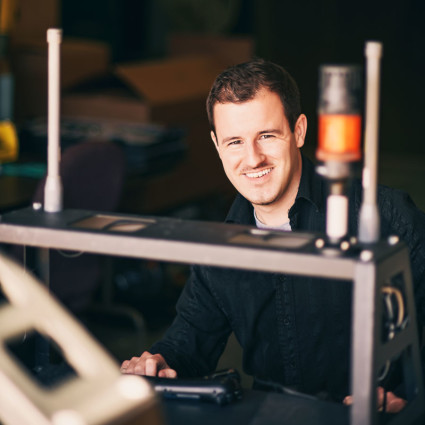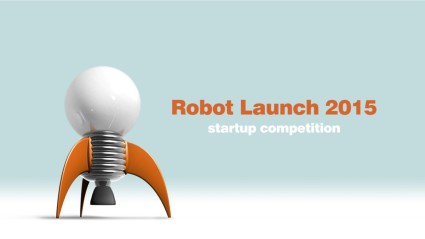
Robohub.org
Coming of age: Clearpath’s Ryan Gariepy on growing a robotics startup

Launched in 2009 by a group of Waterloo engineering students, Clearpath‘s unmistakeable bright yellow and black robots have become synonymous with unmanned vehicle research in university research labs around the world. Now, as the field of robotics matures, Clearpath is forging into industrial applications, too. We caught up with CTO Ryan Gariepy at the 2015 Field and Service Robotics conference (FSR), to talk about their roots in research, the role of ROS and open source in their business model, and the challenges and opportunities of launching a robotics startup in Canada.
[HS] You got your start in the business of robotics while you were still a student at Waterloo. What made you decide to launch a robotics company at that time? Did you have a specific project or technology you were developing that made you think, “Hey, this could actually be useful out there!” …? Or was it that you saw the potential in the field more generally?
 [RG] We started Clearpath right out of university in 2009 as we finished our undergraduate degrees – I did my Masters at the same time as we were getting off the ground, which is generally regarded to be a bad idea in terms of stress levels. It’s hard to believe that we just celebrated our sixth anniversary this year.
[RG] We started Clearpath right out of university in 2009 as we finished our undergraduate degrees – I did my Masters at the same time as we were getting off the ground, which is generally regarded to be a bad idea in terms of stress levels. It’s hard to believe that we just celebrated our sixth anniversary this year.
Starting the company was less about the technology and more about the potential … we just looked at everything around us and said, “Why do we have to shovel snow? This can be automated. Why do we have to do any work that does not require human creativity?” There are a lot of dangerous jobs out there that most people don’t realize are performed on a daily basis by tens of thousands of people in order to keep society going, like mining, farming, construction, stocking warehouses. And yet we need fuel and food and buildings, and we want our same-day deliveries from the Internet. There is a demand for this kind of work to take place.
Around the time we were starting out, Google Maps was getting off the ground. The concept of having information available at your fingertips was also becoming compelling and valuable to people, and the best way to get information about the world on a constant basis is to involve robotics or automation in some form. At the same time, sensors and the cost of sensing were improving due to the rapid uptake in smart phones; we were seeing advances in laptops, smartphones, and electric and hybrid vehicles driving down costs and improving battery density.
People now accept that robotics, automation, and intelligent systems can actually solve some of their problems.
All of this was coming together and we felt that autonomous robotics was possible at a relatively high reliability and low cost, especially when compared with what had been done before.
What would you say have been the biggest changes that you’ve seen in the field of robotics since then?
I think one of the biggest changes is simply that people now accept that robotics, automation, and intelligent systems can actually solve some of their problems.
This recognition means that there are a lot of opportunities out there, both in terms of hardware and software. In some industries – ones that have been around for a long time – they already know how to build solid hardware that could be made robotic, but they need the right parts and the right software to automate it. Then there are other industries that need full solutions. There are a lot of pieces starting to come together now.
Your early customer base was made up of mainly universities and research labs. Do you find yourself getting pulled into a different direction now that you’re expanding more into industry?
The research market is definitely maturing and our product development cycle within that side of the business is very well understood. We’ve released two completely different platforms in the last eight months alone.
Now we are in a position where we can leverage the experience we gained from the R&D market to address challenges in industry. We are actively pushing the development of full robotic solutions (including software), and will soon be releasing a new platform along these lines.
How do you manage the problem of building in more than one direction at the same time?
One of our biggest challenges is that there is no one single clear challenge, especially at the scale we’re at right now. At this stage there are many things that need to be focused on: sales, operations, quality assurance, new features, understanding where the market’s going, product management, marketing … so the challenge is more about managing the priorities of any given department.
How do I provide guidance to the team so that they can spend their time on the right tasks? How do we remain dynamic as a startup? How do we remain flexible enough to change direction quickly if we need to, but still be stable enough to stick to our core values? These are the kinds of questions we are dealing with.
Speaking of core values, Clearpath took a chance from the beginning by focusing on open source and ROS. Does open source make for a good business model?
Why open source? No matter how large a company we become, there will always be more smart people who can build and program robots outside our company than within it.
One of the reasons we looked at open source was the philosophy that no matter how large a company we become, there will always be more smart people who can build and program robots outside our company than within it. So it’s only logical that we work with whatever the community ends up creating around open source robotics, both to reinforce the community, and to hire from it.
That said, from a business model perspective it is more complicated. There are many companies that succeed with open source, but there is still no clear-cut model for building an open source company – and that tends to make people nervous. And yet by now we’ve seen several companies build on open source, including Google and Facebook, and it’s the same thing as building a startup on a LAMP stack: yes, you use open source and you may push back some code to open source, but you still have value you’re bringing on your own.
Earlier on we sold only hardware, which is easier to protect. Now that we’re getting into software sales, open source creates additional considerations for us, but it still hasn’t been an issue. Building on open source makes us more effective, and it certainly helps us engage much more with the robotics community.
Now that you’ve done all the legwork of developing the product and proving the market, do you have any concerns that another company with more resources could just come along and say, “We know who their buyers are, and we know what their markets are, and we can imitate their products …”?

Clearpath is sponsoring the 2015 Robot Launch “Open Source Robotics” Award, offering 10 hours of ROS consulting services to the winner.
ROS is open source and we contribute a lot back to it. We test a lot, we support people, we contribute drivers, and we contribute utilities back. However, the work that we do on autonomy and in controls –planning, mapping localization, interfacing, vehicle management – is not open source. We may open source parts of it in the future as we advance our state of the art, but the ‘secret sauce’ is still closed, even though it’s built on ROS middleware.
Could it make life easier for our competitors in some cases? Yes, but by the same token nobody makes money on having a better robot-logging framework, for example, and everybody saves money by having a good free robot-logging framework. If a better logging framework is your only competitive advantage, it’s not really an advantage, is it? Personally, I’d rather not spend money on a logging framework, and spend more to compete on the actual value that we bring to our clients.
You mentioned snow shoveling as one of your inspirations, which is a stereotypically Canadian problem. Did the Canadian climate and landscape figure into your business plan from the beginning? Is that why you wound up in field and service robotics, as opposed to some other application area?
Of course our robots can survive the winter – we’re Canadian!
One of our competitive advantages is the terrible weather we have in Canada. We have harsh winters, we have a lot of forestry, a lot of primary resources to mine and harvest, and we have a lot of space that is sparsely populated, which makes it easier to do testing. We also happen to have a very well developed technology ecosystem here. When you put those things together, it’s natural to lean towards field robotics.
When we started there were very few platforms out there that could actually do field robotics, and so we set that as our first niche.
How is the Canadian business landscape for robotics?
Many of our first customers were Canadian universities, some of which are leading the way in robotics integration and research. Meanwhile, Industry Canada is looking at how robotics technology can be adapted to existing manufacturing clusters in Southwestern Ontario, like the auto sector, which took a hit when the North American auto industry had a downturn. Canada also has strengths such as communications and optics, which naturally extend into robotics. It also helps when we can do business with Canadian suppliers; we get our GPS’ from NovAtel, which is based in Calgary, for example.
That said, as a Canadian company you’re forced to go multinational almost instantly because there isn’t enough of a robotics market in Canada to stay Canadian for long. We recently announced that we’ll be expanding office space into Silicon Valley and a primary reason for that is because of the opportunity that is available in the US market. Regardless, the Waterloo Region will continue to be Clearpath’s ‘home base’ for the foreseeable future.
People now refer to Waterloo as ‘Silicon Valley North’. What’s changed in the incubation space where Clearpath grew up since you launched?
It used to be that investors would demand that you move to the area where their office was, which was typically Boston or New York City or Silicon Valley, but that’s not always the case anymore.
It used to be that investors and venture capitalists would demand that you move to the area where their office was, which was typically Boston or New York City or Silicon Valley, but that’s not always the case anymore. Investors are starting to recognize that there are also benefits to being in other locations, especially for startups. Waterloo has a very dynamic tech community. It’s also a quarter of the price to buy a house here than in some of those larger US cities, and the time it takes me to get to work is 10 minutes, which makes it pretty livable and affordable compared to Silicon Valley. We found that VCs are now willing to accept that good ideas and businesses can grow and thrive in other areas as long as these areas have the right attitude – and Waterloo certainly has that.
Take the displacement of BlackBerry employees for instance – quite a few very smart people who were working at Blackberry have moved on to bring their skills and experience to other industries. We’ve hired a number of them, and a number of them have gone off to launch their own startups.
On top that is the continual increase in the brand of the Waterloo Region, and specifically the University of Waterloo (UW), as the place to go for getting a great education and practical experience that can lead to entrepreneurship. YCombinator’s Paul Graham has noted that UW has a fantastic record for turning out very strong companies, specifically hardware companies.
The other change worth mentioning is that Clearpath isn’t alone. The first group of startups that came out of UW includes Pebble, Vidyard, and more recently Thalmic Labs. These are all people who have graduated from UW’s engineering program within a few years of each other.
Does that help, too? Having a cluster that’s grown up together?
It certainly does.
Take recruiting, for example. When you’re hiring someone it helps prospective employees to know that there are other options. Clearpath has hired quite a few people from outside the region and if you’re taking a risk and moving a few thousand kilometers to join us, it’s good to know that there are other companies around, whether it’s for future growth opportunities, shared interests, or participating in knowledge transfer. For prospective employees, knowing that you can get back on your feet if you need to, or that your partner can find a job in the region, is very useful.
There is also something to be said for being part of a startup community. We all know each other, and we try to mentor each other. Even if you’re not working in exactly the same market, you can look at other startups and see them succeeding – and this is evidence that you can do it too.
tags: c-Business-Finance, Canada, Clearpath, field robotics, FSR, Interview, open source, Robot Launch, ROS, Ryan Gariepy, startup


